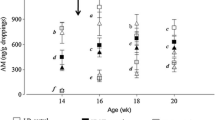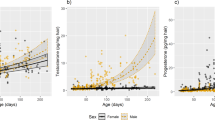Abstract
Micropopulations consisting of six male mice of different genotypes were studied (each of lines A/He, CBA/Lac, C57BL/6J, DD, YT, and PT was represented by one male). Interlinear differences in the level of social dominance and the effects of genotype, social hierarchy, and season on in vitro testosterone production by testes were examined under different incubation conditions. The testosterone production was estimated under control conditions and under stimulation with human chorionic gonadotropin (CG). Significant genetic differences in the initial and CG-stimulated testosterone production by testes incubated in vitro were found. By the control production, the genotypes fell into two groups: lines C57BL/6J, A/He, and CBA/Lac had low production of the hormone; lines YT, PT, and DD, high production. By responsiveness of gonads to CG, the genotypes fell into three groups: line CBA/Lac had low testosterone production by testes; lines C57BL/6J, A/He, YT, and DD, line PT, intermediate production; and line PT, high production. The obtained data indicate stability of genetic polymorphism for the responsiveness of testes to gonadotropins, because neither season nor the formation of social hierarchy could significantly change the interlinear differences. In line PT characterized by high hormonal activity of gonads in the control and under stimulation with gonadotropins, males became dominant in a significantly greater number of cases studied during the formation of hierarchy in micropopulations. The dynamics of both control production of a male sex hormone and responsiveness of testes to CG was established in vitro during the formation of social hierarchy; the effects of season on this dynamics were revealed. Specific characteristics of secretory activity of testes were detected in the control and under stimulation with gonadotropins, depending on incubation conditions. Seasonal and genotypic characteristics of the responsiveness of testes to CG were revealed under different incubation conditions. Genotypic characteristics indicate interlinear differences in the degree of inertia of testosterone biosynthesis on exposure to gonadotropins.
Similar content being viewed by others
REFERENCES
Bartke, A., Increased Sensitivity of Seminal Vesicles to Testosterone in a Mouse Strain with Low Plasma Testosterone Levels, J. Endocrinol., 1974, vol. 60, no. 1, pp. 145-148.
Selmanoff, M.K., Abreu, E., Goldman, B.D., and Ginsburg, B.E., Manipulation of Aggressive Behavior in Adult DBA/2/Bg and C57BL/10/Bg Male Mice Implanted with Testosterone in Silastic Tubing, Horm. Behav., 1977, vol. 8, no. 3, pp. 377-390.
Osadchuk, A.V. and Naumenko, E.V., Role of the Genotype and Several Types of Zoocosial Behavior in Regulating the Endocrine Function of the Testes in Mice, Dokl. Akad. Nauk SSSR, 1981, vol. 258, no. 3, pp. 746-749.
Osadchuk, A.V. and Naumenko, E.V., Genetic-Endocrine Mechanisms of Differential Reproduction in Micropopulations in Male Laboratory Mice, Dokl. Akad. Nauk SSSR, 1983, vol. 268, no. 4, pp. 983-987.
Osadchuk, A.V., Microevolutionary Basis of Functions of the Adrenocortical and Generative Systems, in Ontogeneticheskie i genetiko-evolyutsionnye aspekty neiroendokrinnoi regulyatsii stressa (Ontogenetic and Genetic Evolutionary Aspects of Neuroendocrine Regulation of Stress), Novosibirsk: Nauka, 1990, pp. 160-170.
Naumenko, E.V., Osadchuk, A.V., Serova, L.I., and Shishkina, G.T., Genetiko-fiziologicheskie mekhanizmy regulyatsii funktsii semennikov (Genetic Physiological Mechanisms of Regulation of Functions of the Testes), Novosibirsk: Nauka, 1983.
Osadchuk, A.V. and Svechnikov, K.V., Genetic Basis of Adenylate Cyclase Regulation of Testosterone Production in Leydig Cells of Laboratory Mice, Byul. Eksp. Biol. Med., 1994, no. 118, pp. 177-180.
Osadchuk, A.V. and Svechnikov, K.V., Genetic Control of Steroidogenesis in Leydig Cells of Laboratory Mice, Dokl. Ros. Akad. Nauk, Ser. Biol., 1995, vol. 343, no. 2, pp. 281-283.
Osadchuk, A.V. and Svechnikov, K.V., Genetic Control of the Activities of Microsomal Steroidogenesis Enzymes in Leydig Cells of Inbred Mouse Lines, Genetika (Moscow), 1998, vol. 34, no. 9, pp. 1277-1285.
Stalvey, J.R. and Payne, A.H., Luteinizing Hormone Receptors and Testosterone Production in Whole Testes and Purified Leydig Cells from the Mouse: Differences among Inbred Strains, Endocrinology, 1983, vol. 112, no. 5, pp. 1696-1701.
Stalvey, J.R. and Payne, A.H., Maximal Testosterone Production in Leydig Cells from Inbred Mice Relates to the Activity of 3β-Hydroxysteroid Dehydrogenase-Isomerase, Endocrinology, 1984, vol. 115, no. 4, pp. 1500-1505.
Bronson, F.H., The Reproductive Ecology of House Mouse, Quart. Rev. Biol., 1979, vol. 54, pp. 265-299.
Marchlewska-Koj, A., Sociogenic Stress and Rodent Reproduction, Neurosci. Biobehav. Rev., 1997, vol. 21, pp. 699-703.
Christian, J.J., Population Density and Reproductive Efficiency, Biol. Reprod., 1971, vol. 4, pp. 248-294.
Shilov, I.A., Ekologo-fiziologicheskie osnovy populyatsionnykh otnoshenii u zhivotnykh (Ecologo-Physiological Basis of Relationships in Animal Populations), Moscow: Mosk. Gos. Univ., 1977.
Naumenko, E.V., To the Regulation of the Population Size in Mammals, in Rukovodstvo po fiziologii. Ekologicheskaya fiziologiya zhivotnykh (Manual on Physiology: Ecological Physiology of Animals), Leningrad: Nauka, 1979, pp. 318-341.
Tähkä, K.M., Current Aspects of Leydig Cell Function and Its Regulation, J. Reprod. Fert., 1986, vol. 78, pp. 367-380.
Kotenkova, E.V., Meshkova, N.N., and Shutova, M.I., O krysakh i myshakh (On Rats and Mice), Moscow: Nauka, 1989.
Serova, L.I., Osadchuk, A.V., and Naumenko, E.V., Genetic Neurochemical Analysis of Brain Catecholamines in Population Hierarchy of Male Laboratory Mice, Genetika (Moscow), 1989, vol. 25, no. 4, pp. 691-698.
Brain, P.F., Pituitary Gonadal Influences on Social Aggression, Hormones and Aggressive Behavior, Svare, B.B., Ed., New York: Plenum, 1983, pp. 3-25.
Osadchuk, A.V., Social, Hormonal, and Genetic Basis of Differential Reproduction in Mice, International Society for Research on Aggression: XII World Meet., Strasbourg, 1996, p. 75.
River, C. and Rivest, S., Effect of Stress on the Activity of Hypothalamic-Pituitary-Gonadal Axis: Peripheral Central Mechanisms, Biol. Reprod., 1991, vol. 45, pp. 523-532.
Bronson, F.H., Establishment of Social Rank among Grouped Male Mice: Relative Effect on Circulating FSH, LH, and Corticosterone, Physiol. Behav., 1973, vol. 10, pp. 947-951.
Bronson, F.H., Stetson, M.H., and Stiff, M.E., Serum FSH and LH in Male Mice Following Aggressive and Nonaggressive Interaction, Physiol. Behav., 1973, vol. 10, pp. 167-372.
Taylor, G.T., Weiss, J., and Rupich, R., Male Rat Behavior, Endocrinology, and Reproductive Physiology in a Mixed-Sex, Socially Stressful Colony, Physiol. Behav., 1987, vol. 39, pp. 429-433.
Bartke, A., Hikim, A.P.S., and Russel, L.D., Leydig Cell Structure and Function in Seasonal Breeders, The Leydig Cell, Payne, A.H., Hardy, M.P., and Russel, L.D., Eds., Vienna: Cacher River Press, 1996, pp. 431-450.
Author information
Authors and Affiliations
Rights and permissions
About this article
Cite this article
Busygina, T.V., Osadchuk, A.V. Role of Genotype, Social Stress, and Season in the Regulation of Hormonal Function of Testes Incubated in Vitro in Mice. Russian Journal of Genetics 37, 85–93 (2001). https://doi.org/10.1023/A:1009078827694
Issue Date:
DOI: https://doi.org/10.1023/A:1009078827694




